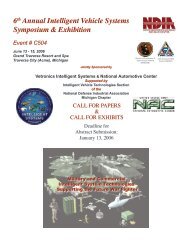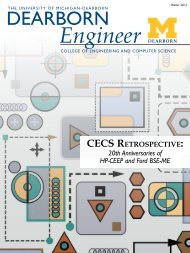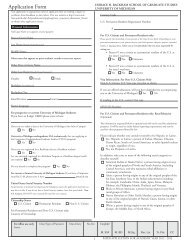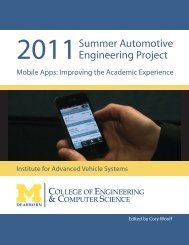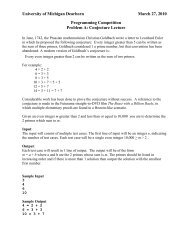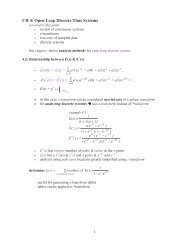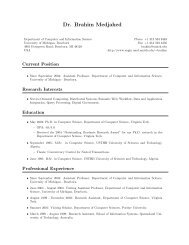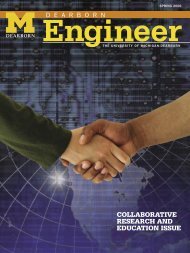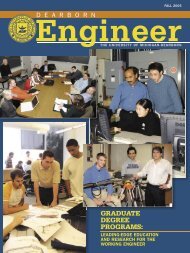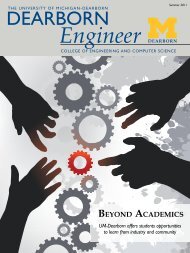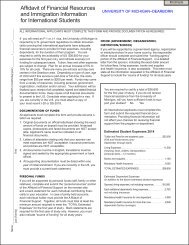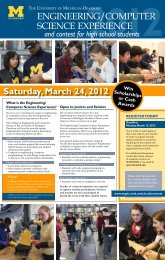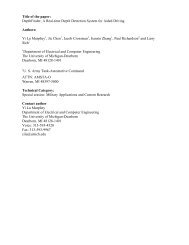Certificate: Automotive Systems Engineering
Certificate: Automotive Systems Engineering
Certificate: Automotive Systems Engineering
Create successful ePaper yourself
Turn your PDF publications into a flip-book with our unique Google optimized e-Paper software.
<strong>Certificate</strong>: <strong>Automotive</strong> <strong>Systems</strong> <strong>Engineering</strong><br />
The automotive system of the twenty-first century is poised to advance at a rapid pace<br />
with greater emphasis on lightweight structures, high efficiency powertrains, intelligent<br />
control systems, lower emissions, robust design and manufacturing, as well as improved<br />
comfort and safety. The profession requires that engineers make connections among<br />
different areas of knowledge, integrating them in ways that benefit the automotive<br />
industry, society, and the environment. (12 credit hours)<br />
<strong>Automotive</strong> <strong>Systems</strong> <strong>Engineering</strong> <strong>Certificate</strong> Area #1: <strong>Automotive</strong> Energy <strong>Systems</strong><br />
AENG 596 Internal Combustion Engines I<br />
3 credits<br />
Comparison of several forms of internal combustion engines including Otto and dieseltype<br />
piston engines; performance parameters and testing, thermodynamic cycles and fuelair<br />
cycles, combustion in SI and Diesel engines, charge formation and handling, ignition,<br />
elements of exhaust emissions.<br />
AENG 598 Energy <strong>Systems</strong> for <strong>Automotive</strong> Vehicles<br />
3 credits<br />
This course will discuss the current or future energy systems for automotive vehicles.<br />
Topics include liquid and gaseous fuels, direct energy conversion systems and fuel cells.<br />
Characteristics of various energy systems are discussed with respect to their performance,<br />
cost reliability, and environmental concerns. Fuel cell analysis and design is covered in<br />
detail.<br />
ME 597 Internal Combustion Engines II<br />
3 credits<br />
Fuel flow and air flow measurements and techniques; engine maps, fuel and ignition<br />
control and control strategies; combustion and burn rate considerations in engine design,<br />
intake and exhaust systems, emissions and control strategies, emission test procedures.<br />
ME 598 Engine Emissions<br />
3 credits<br />
This course introduces students to the fundamentals of engine exhaust emissions,<br />
including their formation mechanisms and abatement techniques. The students will be<br />
familiarized with the present emission control technologies and future challenges. The<br />
topics covered include: engine emissions and air pollution, review of emission<br />
regulations, catalyst fundamentals, catalyst-based engine after treatment techniques for<br />
gasoline, diesel, and lean-burn engines, discussion of cold-start emission control and<br />
breakthrough catalytic technologies.<br />
Updated 3/05<br />
*Other courses are available for all certificate topic areas with approval of department advisor.
ECE 546 Electric Vehicles<br />
3 credits<br />
Fundamental concepts and specifications; energy sources, motors for electric vehicles,<br />
controllers and power electronics; engineering impact of electric vehicles.<br />
<strong>Automotive</strong> <strong>Systems</strong> <strong>Engineering</strong> <strong>Certificate</strong> Area #2: <strong>Automotive</strong> Materials<br />
AENG 581 Materials Selection in <strong>Automotive</strong> Design<br />
3 credits<br />
This course develops the understanding of the properties of modern engineering materials<br />
and explains the role of the materials selection process in product design, development,<br />
and manufacturing. Materials selection/design problems and case studies involving<br />
automotive and other commercial products are discussed. The role of environmental<br />
regulations, societal pressures and customer wants in the selection of alternate materials<br />
is discussed.<br />
AENG 584 Lightweight <strong>Automotive</strong> Alloys<br />
3 credits<br />
This course introduces structure-processing-property relationships in lightweight<br />
automotive alloys that are candidates for automotive applications such as aluminum,<br />
titanium, and magnesium. Metal matrix composite and intermetallic materials are also<br />
discussed. Emphasis will be placed on the processing and design of these materials in<br />
future automotive applications.<br />
AENG 585 Ceramics for <strong>Automotive</strong> Applications<br />
3 credits<br />
This course will present physical, thermal and mechanical properties of structural<br />
ceramics, ceramic coatings and ceramic matrix composites. Design and processing issues<br />
for these materials are emphasized. <strong>Automotive</strong> applications of ceramics are discussed.<br />
Thermoelectric and other propulsion materials are also discussed.<br />
AENG 586 Design and Manufacturing: Lightweight <strong>Automotive</strong> Materials<br />
3 credits<br />
This course will address the design issues and manufacturing considerations for various<br />
lightweight automotive structural materials. Design issues will include stiffness, fatigue,<br />
vibrations, dent resistance, crush resistance, etc. Methods of producing lightweight<br />
automotive structures are discussed. Design for manufacturing, assembly, disassembly<br />
and recycling are emphasized.<br />
ME 584 Mechanical Behavior of Polymers<br />
3 credits<br />
Mechanical behavior of polymers and ceramics are considered in relation to their<br />
structures, processing and applications. Emphasis is given to their deformation, fatigue<br />
and fracture characteristics. Strengthening mechanisms for both materials are discussed.<br />
Updated 3/05<br />
*Other courses are available for all certificate topic areas with approval of department advisor.
ME 587 <strong>Automotive</strong> Composites<br />
3 credits<br />
The emphasis in this course is on automotive composites, such as SMC, SRIM and RTM.<br />
In addition to properties and applications of these materials, this course covers<br />
manufacturing processes, design considerations, test methods and quality control<br />
techniques used for automotive composites. The use of continuous fiber composites in<br />
automotive applications, such as leaf springs, drive shafts and energy absorbing<br />
structures are also discussed.<br />
<strong>Automotive</strong> <strong>Systems</strong> <strong>Engineering</strong> <strong>Certificate</strong> Area #3: Vehicle Design<br />
AENG 545 Vehicle Ergonomics I<br />
3 credits<br />
Overview of drive characteristics, capabilities, and limitations. Human variability and<br />
driver demographics, driver performance measurements. Driver information processing<br />
models, driver errors and response time. Driver sensory capabilities, vision, audition,<br />
and other inputs. Vehicle controls and displays. Driver anthropometry, biomechanical<br />
considerations.<br />
AENG 546 Vehicle Ergonomics II<br />
3 credits<br />
This course covers advanced human factors engineering and ergonomics topics related to<br />
incorporation and integration of new display, information, lighting and sensor<br />
technologies to improve driver convenience, performance, safety and to reduce driver<br />
distractions. The students will learn new evaluation methodologies, driver performance<br />
models and use research equipment to measure driver performance and evaluate usability<br />
issues. Some advanced topics to be covered include: driver workload, evaluation and<br />
design of new in-vehicle devices, advanced lighting and driver vision systems, models to<br />
predict and evaluate field of view, target detection, disability and discomfort glare,<br />
legibility, etc.<br />
AENG 550 Design of <strong>Automotive</strong> Chassis and Body <strong>Systems</strong><br />
3 credits<br />
This course provides a systems approach to the design of automotive chassis and body<br />
components and examines the influence of their design on the overall structural<br />
performance of the automobile. Design issues related to structural rigidity, ride comfort,<br />
safety and crash-worthiness, durability and assembly are covered. Applications of<br />
advanced materials and joining techniques are discussed. Analytical tools used in<br />
automotive structural design are also discussed.<br />
AENG 565<br />
3 credits<br />
Updated 3/05<br />
Vehicle Acoustic Interior System Design<br />
*Other courses are available for all certificate topic areas with approval of department advisor.
This course presents the technology and methodology of vehicle acoustic interior system<br />
design. Design of five main interior subsystems, namely dash panel, floor panel, roof,<br />
door aperture, and trunk, as well as the whole vehicle will be covered. Both analytical<br />
and experimental methods for transmission loss analysis and validation testing will be<br />
discussed in detail. Statistical Energy Analysis (SEA) will be used to calculate the power<br />
distribution within the subsystems. Determination of damping loss factors and coupling<br />
loss factors will be covered. Acoustical material property and material testing will be<br />
discussed. Case studies of optimizing acoustic packages of subsystem and the whole<br />
vehicle will be presented. The course also includes computer simulation using<br />
commercial software and experimental demonstrations.<br />
ME 543 Vehicle Dynamics<br />
3 credits<br />
A treatment of the response, ride and maneuvering of motor vehicles. Road loads,<br />
suspension systems, mechanics of pneumatic tires.<br />
ME 558 Fracture & Fatigue Considerations in Design<br />
3 credits<br />
A comprehensive review of fracture and fatigue processes in engineering materials with<br />
emphasis on mechanisms instead of failure. Design methodology based upon fracture<br />
toughness and fatigue crack propagation is presented.<br />
IMSE 593 Vehicle Package <strong>Engineering</strong><br />
3 credits<br />
Vehicle package specifications related to exterior and interior design reference points,<br />
dimensions and curb loadings. Benchmarking package studies, ergonomic tools and<br />
design practices used in the automobile industry. Driver positioning considerations, seat<br />
height, heel points, hip points, steering wheel location, seat pan and back angles. Pedal<br />
design issues, tear shaft positioning. Visibility of instrument panel space. Armrest and<br />
console design considerations. Principles and considerations in selecting and location<br />
types and characteristics of controls and displays on instrument panels, doors, consoles,<br />
and headers. Engine compartment packaging issues. Perception of interior spaciousness<br />
and visibility of the road over cowl and hood.<br />
Updated 3/05<br />
*Other courses are available for all certificate topic areas with approval of department advisor.
<strong>Automotive</strong> <strong>Systems</strong> <strong>Engineering</strong> <strong>Certificate</strong> Area #4: <strong>Automotive</strong> Electronics &<br />
Controls<br />
AENG 505 Digital <strong>Systems</strong> and Microprocessors<br />
3 credits<br />
Introduction to modern digital computer logic. Numbers and coding systems, Boolean<br />
algebra with applications to logic systems, combination and sequential logic design,<br />
examples of digital logic circuits, simple machine language programming; macro<br />
processor-programming, input/output, interrupts, and system design.<br />
AENG 510 Vehicle Electronics I<br />
3 credits<br />
Semiconductor diodes, junction transistors, FETS, rectifiers and power supplies, small<br />
signal amplifiers, biasing considerations, gain-bandwidth limitations, circuits models,<br />
automotive applications and case studies.<br />
ECE 515 Vehicle Electronics II<br />
3 credits<br />
CD ignition, high speed switching, motor drive control, inverters, PWM controllers,<br />
active filters, signal conditioners, power electronics, voltage regulators. Selected topics,<br />
ASICS, RF amplifiers, battery chargers, solar cells.<br />
ECE 531 Intelligent Vehicle <strong>Systems</strong><br />
3 credits<br />
The course covers important technologies relevant to intelligent vehicle systems<br />
including: systems architecture, in-vehicle electronic sensors, traffic modeling and<br />
simulation. Students will design and implement algorithms and simulate driver-highway<br />
interactions.<br />
ECE 532 <strong>Automotive</strong> Sensors and Actuators<br />
3 credits<br />
Study of automotive sensory requirements, types of sensors, available sensors and future<br />
needs. Study of functions and types of actuators in automotive systems. Dynamic<br />
models of sensors and actuators. Integrated smart sensors and actuators. Term project.<br />
ECE 565 Digital Control <strong>Systems</strong><br />
3 credits<br />
Mathematical representation of digital control systems; z-transform and differential<br />
equations, classical and state space methods of analysis and design, direct digital control<br />
of industrial processes.<br />
Updated 3/05<br />
*Other courses are available for all certificate topic areas with approval of department advisor.



